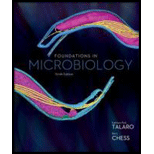
Foundations in Microbiology
9th Edition
ISBN: 9780073522609
Author: Kathleen Park Talaro, Barry Chess Instructor
Publisher: McGraw-Hill Education
expand_more
expand_more
format_list_bulleted
Concept explainers
Textbook Question
Chapter 14.L1, Problem 9MCQ
Toll-like receptors are proteins on ___________
a. phagocytes that recognize foreign molecules
b. viruses that stimulate immune reactions
c. skin cells that provide barriers to infection
d. lymphocytes that damage
Expert Solution & Answer
Want to see the full answer?
Check out a sample textbook solution
Students have asked these similar questions
Explain in a small summary how:
What genetic information can be obtained from a Punnet square? What genetic information cannot be determined from a Punnet square?
Why might a Punnet Square be beneficial to understanding genetics/inheritance?
In a small summary write down:
Not part of a graded assignment, from a past midterm
Chapter 14 Solutions
Foundations in Microbiology
Ch. 14.1 - Summarize the characteristics of basic host...Ch. 14.1 - Differentiate between the three lines of defense,...Ch. 14.1 - Explain the nature of the different types of...Ch. 14.1 - Explain the functions of the three lines of...Ch. 14.1 - What is the difference between nonspecific host...Ch. 14.1 - Differentiate innate defenses and acquired...Ch. 14.1 - Prob. 4CYPCh. 14.2 - Prob. 4ELOCh. 14.2 - Describe several features of the recognition...Ch. 14.2 - Characterize pattern recognition receptors and...
Ch. 14.2 - Describe the microscopic anatomy of body...Ch. 14.2 - Prob. 8ELOCh. 14.2 - Prob. 9ELOCh. 14.2 - Prob. 10ELOCh. 14.2 - Prob. 11ELOCh. 14.2 - Prob. 5CYPCh. 14.2 - Prob. 7CYPCh. 14.2 - What are the main components of the...Ch. 14.2 - Prob. 9CYPCh. 14.2 - Prob. 10CYPCh. 14.2 - Prob. 11CYPCh. 14.2 - Prob. 12CYPCh. 14.2 - Prob. 13CYPCh. 14.2 - What is Lymph, and how is it formed?Ch. 14.2 - Prob. 15CYPCh. 14.2 - Prob. 16CYPCh. 14.3 - Describe the main events in the inflammatory...Ch. 14.3 - Prob. 13ELOCh. 14.3 - Describe the mechanism behind fever, and explain...Ch. 14.3 - Describe the major events in the inflammatory...Ch. 14.3 - Of rubor, calor, dolor, and tumor, which are signs...Ch. 14.3 - Prob. 19CYPCh. 14.3 - Prob. 20CYPCh. 14.3 - Prob. 21CYPCh. 14.3 - Prob. 22CYPCh. 14.3 - Explain the processes of diapedesis and...Ch. 14.3 - Prob. 24CYPCh. 14.4 - Prob. 15ELOCh. 14.4 - Indicate the major stages of phagocytosis, and...Ch. 14.4 - Prob. 17ELOCh. 14.4 - Prob. 18ELOCh. 14.4 - Characterize the complement system, its origins,...Ch. 14.4 - Prob. 25CYPCh. 14.4 - What are the types of macrophages, and what are...Ch. 14.4 - Prob. 27CYPCh. 14.4 - Prob. 28CYPCh. 14.4 - Prob. 29CYPCh. 14.4 - Prob. 30CYPCh. 14.4 - Prob. 31CYPCh. 14.4 - Using figure 14.21 as a guide, give examples for...Ch. 14.L1 - An example/examples of a nonspecific chemical...Ch. 14.L1 - Prob. 2MCQCh. 14.L1 - Prob. 3MCQCh. 14.L1 - Prob. 4MCQCh. 14.L1 - What is included in GALT? a. thymus b. Peyer’s...Ch. 14.L1 - Prob. 6MCQCh. 14.L1 - Monocytes are ___________ leukocytes that develop...Ch. 14.L1 - Prob. 8MCQCh. 14.L1 - Toll-like receptors are proteins on ___________ a....Ch. 14.L1 - Prob. 10MCQCh. 14.L1 - __________ is an example of an inflammatory...Ch. 14.L1 - Prob. 12MCQCh. 14.L1 - _________ interferon, produced by T lymphocytes,...Ch. 14.L1 - In what process is tumor necrosis factor (TNF) not...Ch. 14.L1 - Which of the following substances is not produced...Ch. 14.L1 - Prob. 16MCQCh. 14.L1 - Prob. 1CSRCh. 14.L1 - Prob. 2CSRCh. 14.L1 - Prob. 3CSRCh. 14.L1 - Prob. 1WCCh. 14.L1 - Prob. 2WCCh. 14.L1 - Prob. 3WCCh. 14.L1 - Prob. 4WCCh. 14.L1 - Prob. 5WCCh. 14.L1 - Prob. 6WCCh. 14.L1 - Discuss the multiple, overlapping functions of the...Ch. 14.L1 - Prob. 8WCCh. 14.L1 - Prob. 10WCCh. 14.L1 - Prob. 9WCCh. 14.L2 - Suggest some reasons that there is so much...Ch. 14.L2 - Prob. 2CTCh. 14.L2 - Prob. 3CTCh. 14.L2 - Prob. 4CTCh. 14.L2 - Explain why the X-linked form of CGD is more...Ch. 14.L2 - An obsolete treatment for syphilis involved...Ch. 14.L2 - Patients with a history of tuberculosis often show...Ch. 14.L2 - Shigella, Mycobacterium, and numerous other...Ch. 14.L2 - Account for the several inflammatory symptoms that...Ch. 14.L2 - Prob. 10CTCh. 14.L2 - Prob. 1VC
Knowledge Booster
Learn more about
Need a deep-dive on the concept behind this application? Look no further. Learn more about this topic, biology and related others by exploring similar questions and additional content below.Similar questions
- Noggin mutation: The mouse, one of the phenotypic consequences of Noggin mutationis mispatterning of the spinal cord, in the posterior region of the mouse embryo, suchthat in the hindlimb region the more ventral fates are lost, and the dorsal Pax3 domain isexpanded. (this experiment is not in the lectures).a. Hypothesis for why: What would be your hypothesis for why the ventral fatesare lost and dorsal fates expanded? Include in your answer the words notochord,BMP, SHH and either (or both of) surface ectoderm or lateral plate mesodermarrow_forwardNot part of a graded assignment, from a past midtermarrow_forwardNot part of a graded assignment, from a past midtermarrow_forward
- please helparrow_forwardWhat does the heavy dark line along collecting duct tell us about water reabsorption in this individual at this time? What does the heavy dark line along collecting duct tell us about ADH secretion in this individual at this time?arrow_forwardBiology grade 10 study guidearrow_forward
arrow_back_ios
SEE MORE QUESTIONS
arrow_forward_ios
Recommended textbooks for you
 Medical Terminology for Health Professions, Spira...Health & NutritionISBN:9781305634350Author:Ann Ehrlich, Carol L. Schroeder, Laura Ehrlich, Katrina A. SchroederPublisher:Cengage Learning
Medical Terminology for Health Professions, Spira...Health & NutritionISBN:9781305634350Author:Ann Ehrlich, Carol L. Schroeder, Laura Ehrlich, Katrina A. SchroederPublisher:Cengage Learning

Medical Terminology for Health Professions, Spira...
Health & Nutrition
ISBN:9781305634350
Author:Ann Ehrlich, Carol L. Schroeder, Laura Ehrlich, Katrina A. Schroeder
Publisher:Cengage Learning





Immune System Diseases and Disorders; Author: Heather Davis;https://www.youtube.com/watch?v=3lIkxNv7MVI;License: Standard youtube license